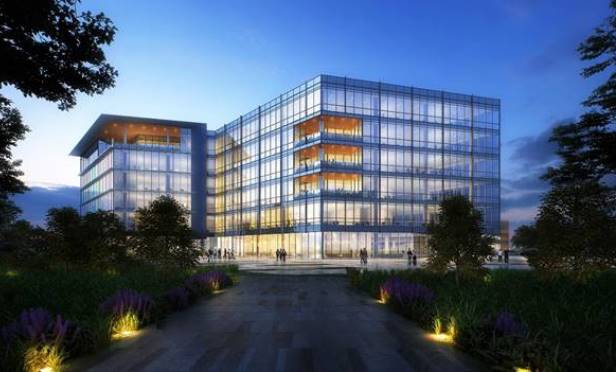 McKinney's tallest building, Independent Bank Group's new headquarters, recently topped out.
McKinney's tallest building, Independent Bank Group's new headquarters, recently topped out.
McKINNEY, TX—Topping out is a normal occurrence in commercial construction. What is noteworthy about a recent topping out is the type of glass that is used in the building's materials.
McKinney's tallest building, Independent Bank Group's new 165,000-square-foot corporate headquarters, recently topped out at the McKinney Corporate Center Craig Ranch. The building is situated on a 10.4-acre parcel at State Highway 121 and Grand Ranch Parkway, at the entrance of the corporate center. Approximately 400 employees are expected to occupy the new headquarters, slated for completion in February 2019.
The building's glass exterior and expansive terraces are designed to bring the outside in and are complemented by a mature greenbelt. The new headquarters will be enclosed with smart glass, providing occupants with unobstructed views of the water feature and access to optimized natural daylight, which will help promote a more productive and healthier environment. Employees will also have direct access to walking trails that connect a proposed mixed-use development.
“The new Independent Bank Group headquarters will be enclosed with View Dynamic Glass, providing occupants unobstructed views and access to optimized natural daylight with no blinds required,” Mahesh Tharoor, regional director, View Inc. tells GlobeSt.com. “Bank employees will be empowered to be more productive and thrive in a healthier environment fueled by an abundant supply of natural light.”
Developer KDC is pursuing LEED Silver certification. The project team includes commercial real estate firm Avison Young, design firm SmithGroup and general contractor Rogers-O'Brien.
Controlled daylight unlocks significant health and wellness benefits for office workers. Studies have shown employees in buildings with View Dynamic Glass report less (51%) incidences of eyestrain, a 63% drop in headaches and a 56% reduction in drowsiness, all of which can adversely impact productivity.
Enhanced individual performance is tied to access to natural light. Workers sitting close to smart windows with optimized daylight exposure reported a 2% increase in productivity or the equivalent of an additional $100,000 per year of value for every 100 workers or around $2 million during a window's lifetime.
By providing uninterrupted views, rejecting glare and heat, and optimizing natural light, dynamic glass is proven to contribute to a healthier, more energetic workforce. Workers in offices with smart glass reported an 82% improvement in daylight quality.
Earlier this year, View announced the results of a study on the impact of in-terminal passenger experience and its correlation to higher revenues and reduced operational expenses. The survey, undertaken by Dr. Alan Hedge of Cornell University in conjunction with Dallas-Fort Worth International Airport, found that terminal windows fitted with View Dynamic Glass overwhelmingly improved passenger comfort over conventional glass, resulting in an 83% increase in passenger dwell time at a preferred gate seat and a 102% increase in concession spending. The research was conducted in tandem with a pilot study conducted by DFW, View Inc. and an independent aviation market research group.
“DFW is the world's largest carbon neutral airport, and we are constantly evaluating new technologies and solutions throughout the airport to identify improvements for customer experience and sustainability,” said Sean Donohue, CEO at DFW Airport. “The results of this study confirm that dynamic glass can reduce cooling costs and support DFW's commitment to minimize our carbon footprint. We were very pleased to see the positive effect on the customer experience and how the glass changed customer behavior with less glare and cooler temperatures.”
© Touchpoint Markets, All Rights Reserved. Request academic re-use from www.copyright.com. All other uses, submit a request to [email protected]. For more inforrmation visit Asset & Logo Licensing.







